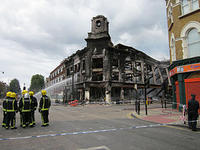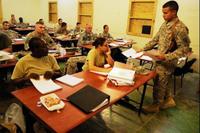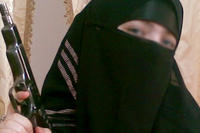-
Social identification, not obedience, is the motive for unspeakable acts
What makes soldiers abuse prisoners? How could Nazi officials condemn thousands of Jews to gas chamber deaths? What is going on when underlings help cover up a financial swindle? For half a decade or so, the dominant view – following the famous Milgram experiments – has been that people engage in barbaric acts because they have little insight into what they are doing and conform slavishly to the will of authority; new research suggests that we need to rethink obedience as the standard explanation for why people engage in cruel and brutal behavior
-
-
Competition among political forces, not religious fundamentalism, inflames anti-Americanism in the Muslim world

Historically, domestic political divisions within Muslim politics have fallen between secular elite and fundamental Islamic elite factions, with both groups laying claims to anti-American grievances; that competition is most intense not in the most deeply observant Islamic countries, but rather in countries where divisions between secular and religious factions are sharpest; in those countries, competition between political forces — not religious fundamentalism — appears to spark the greatest anti-American sentiment
-
-
Will rising temperatures lead to rising crime rates?
General Strain Theory has become one of the leading explanations for crime, and Emory University’s Professor Robert Agnew, has become its chief architect; he argues that rising temperatures will lead to more strains — increased temperatures, heat waves, natural disasters, serious threats to livelihood (farming, herding, fishing), forced migrations on a massive scale, and social conflicts arising as nations and groups compete for increasingly scarce food, fresh water, and fuel – and more strains invariably lead to rising crime rates
-
-
Study: Islamist extremists emphasize self-defense, not world domination
A common belief in the West is that al Qaeda wishes to impose Islam everywhere; this might be a pipe dream for the group, but a new study of their use of religious texts suggests that Islamists’ goals are much more modest
-
-
The U.K. August 2011 riots could have been predicted

Researchers studying urban violence have developed a new method which can help city authorities to assess the conditions where conflict could potentially tip into violence; Participatory Violence Appraisal (PVA), used in Kenya and Chile, could have helped to anticipate the tipping points that led to last summer’s riots in cities across the United Kingdom, the researchers say
-
-
Viewing terrorist attacks on TV increases pain intensity

A new study finds that exposure to media coverage of terrorist missile attacks increases pain levels in people already suffering from chronic pain
-
-
Teaching about Islam in the U.S. military

U.S. Islamic groups complained that course material used by the joint Forces Staff College portrayed Islam in an unflattering light; they also complained about the views of Joint Staff terror analyst Stephen Coughlin, a specialist on Islamic law; the Pentagon last week announced it had completed its review of the issue
-
-
Crowd dynamics explains disaster at cultural, sports events
Physicists investigating a recent crowd disaster in Germany found that one of the key causes was that at some point the crowd dynamics turned turbulent, akin to behavior found in unstable fluid flows
-
-
Turf wars: math model shows crimes cluster on borders between rival gangs

A mathematical model that has been used for more than eighty years to determine the hunting range of animals in the wild holds promise for mapping the territories of street gangs; among other things, the research demonstrates that the most dangerous place to be in a neighborhood packed with gangs is not deep within the territory of a specific gang, as one might suppose, but on the border between two rival gangs
-
-
Belief in hell associated with reduced crime
A broad study, study following143,197 people in sixty-seven countries over twenty-six years, found that criminal activity is higher in societies in which people’s religious beliefs contain a strong punitive component than in places where religious beliefs are more benevolent; a country where many more people believe in heaven than in hell is likely to have a much higher crime rate than one where these beliefs are about equal
-
-
Two new articles in the Journal of Homeland Security Education
Two new articles in the Journal of Homeland Security Education look at important aspects of homeland security: the first examines homeland security academic provisions in the United States and the EU, the second argues that assessing practitioner experience as it relates to subject theory can be challenging, but critically important in homeland defense and security programs where student experiences are often utilized in the process of applying learning objectives
-
-
New eyewitness identification procedure flawed: psychologist
University of California-Riverside psychologist finds that new eyewitness identification procedures may result in fewer correct IDs; the new procedures may, under some circumstances, lead to identification evidence that is less accurate than the identification evidence from the procedures they are designed to replace
-
-
Bios of female terrorists contradict stereotypes: study

Much like their male counterparts, female terrorists are likely to be educated, employed, and native residents of the country where they commit a terrorist act, new research finds
-
-
Counterterrorism expert: democracy in Central Asia lost in translation
Democracy in post-Soviet Central Asia states failed not only because of the region’s Soviet legacy and hardships of transition, but also due to a lack of cultural competence among international, U.S., and EU agencies promoting democracy
-
-
New academic homeland security journal launched
The inaugural issue of a new academic, peer-reviewed journal — the Journal of Homeland Security Education (JHSE)— is out; JHSE will focus on innovative concepts and models, strategies, technical tools, and theoretical and observational analyses; it also provides a platform for translational research that connects education to practice
-
- All
- Regional
- Water
- Biometrics
- Borders/Immig
- Business
- Cybersecurity
- Detection
- Disasters
- Government
- Infrastructure
- International
- Public health
- Public Safety
- Communication interoperabillity
- Emergency services
- Emergency medical services
- Fire
- First response
- IEDs
- Law Enforcement
- Law Enforcement Technology
- Military technology
- Nonlethal weapons
- Nuclear weapons
- Personal protection equipment
- Police
- Notification /alert systems
- Situational awareness
- Weapons systems
- Sci-Tech
- Sector Reports
- Surveillance
- Transportation
Advertising & Marketing: advertise@newswirepubs.com
Editorial: editor@newswirepubs.com
General: info@newswirepubs.com
2010-2011 © News Wire Publications, LLC News Wire Publications, LLC
220 Old Country Road | Suite 200 | Mineola | New York | 11501
Permissions and Policies
Editorial: editor@newswirepubs.com
General: info@newswirepubs.com
2010-2011 © News Wire Publications, LLC News Wire Publications, LLC
220 Old Country Road | Suite 200 | Mineola | New York | 11501
Permissions and Policies
